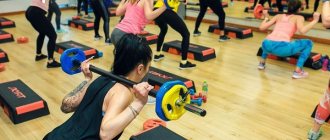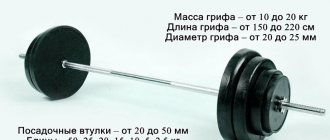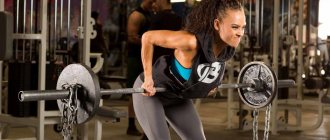Why do you need cardio training?
Cardio training is used primarily to strengthen the cardiovascular system, for weight loss, and to keep the body in good shape. With loads of this type, the speed of blood circulation increases, as a result, the heart muscle is trained, the blood vessels become more elastic, and the development of vegetative-vascular dystonia and respiratory dysfunction are prevented.
With regular cardio training, over time, the body “rebuilds” and begins to accumulate excess carbohydrates in muscles rather than in fat cells. Therefore, the process of losing weight does not happen quickly, but the result is a strong, toned body.
Types of Cardio Training
The simplest type of cardio exercise is walking , especially fast, about 6-7 km/hour. Walking is accessible to almost everyone, regardless of where they live. Of course, at first you should start with a slower speed, then switch to a faster one.
The second simple exercise is running . Here certain difficulties already arise. Firstly, you need special running shoes for running; this will protect your ankle from injury and reduce the load on your knees and spine. Secondly, running is not suitable for overweight people. If such people try to run, and not even in special shoes, they will quickly pay attention to their aching knees and spine. In this case, the best solution would be to replace running with brisk walking.
If you have access to a pool or if you live by the sea, swimming will be a godsend. When swimming, the spine is unloaded and all the muscles of the body are used, accordingly, more calories are burned than in other types of cardio training.
A good form of cardio exercise is cycling . It perfectly develops endurance, burns fat, trains coordination and leg muscles.
A separate category includes exercises performed on simulators . Naturally, you can walk and run not only in the fresh air or in a stadium, but also on a treadmill. In addition to treadmills, in modern fitness centers you can also find other exercise machines - stepper , elliptical and rowing machine, bicycle .
Benefits and disadvantages
The benefits of cardio training are obvious - improving the condition of the circulatory system, heart, respiratory organs, as well as increasing endurance, preventing cardiovascular disease and effectively getting rid of extra pounds.
The disadvantage of cardio exercises is that they require constant monitoring of blood pressure and pulse. It is recommended that everyone measure their pulse before and during training. People with hypertension also need to record their blood pressure readings.
What does cardio training include?
The main condition for cardio exercise is maintaining a certain heart rate for 20-60 minutes. You can get this effect in different ways. This could be a workout in the gym, a workout on the sports ground, or a regular jog.
The main types of cardio training outside the gym are running, walking, swimming. You can run on a treadmill at home or outside. The intensity of running and the duration of the workout depend on the person’s health. Selected by a doctor. If your health suddenly deteriorates while jogging, you need to stop and do some breathing exercises. While jogging, it is important to monitor your heart rate and breathing. People with serious health problems, as well as those suffering from advanced obesity, are not allowed to jog. You need to start running from short distances, gradually increasing them.
A great alternative to running is swimming. Exercises in the pool can be just as effective, but at the same time they provide minimal stress on the spine. Swimming is recommended for people for whom running is contraindicated due to problems with the joints or spine. But for it to give real results, you need to visit the pool regularly, at least 3-4 times a week.
Cardio workouts in the gym are divided into two types. The first of them is classes on special simulators, the second is rhythmic training to music (aerobics or dancing).
Cardio machines for aerobic exercise allow you to set and adjust the load. In addition, when working in a gym with exercise equipment, you can count on the help of a trainer who will teach you how to exercise correctly. With the help of exercise machines, you can achieve a fairly large load, which is almost impossible, for example, with regular running. The most common cardio equipment is an exercise bike, treadmill, and elliptical trainer. There is also more complex modern equipment that expands the range of exercises.
Cardio training at home
I should immediately note that the described training is suitable for both men and women. It is built on the principle of using two-sets, tri-sets, supersets and drop-sets.
What it is - you can find out for yourself. Since most people, I’m sure, don’t have a pool at home, you and I will start with running. Some running exercises will be difficult to do on a treadmill, so give it up right away. Obese people can immediately move on to the second part, and after time has passed, they can also turn on the first. Are you ready to listen? Then let's begin.
Calculate your ideal sports weight!
First part
- Regular running – 5 – 7 minutes.
- Without a break, we continue running with side steps - 1 minute for each side (2 minutes in total)
- Without a break, run with high hips – 1 minute.
- Jogging – 3 minutes.
- Acceleration – 30 seconds.
- Jogging for 1 minute (repeat steps five and six 3 times).
- Running with high hips – 1 minute.
- Regular running – 3 – 5 minutes.
The total running time is from 19.5 to 23.5 minutes.
Second part
- Lifting the dumbbell up – 20 – 25 times; exercise “star” - 1 minute; lifting dumbbells to the sides with straight arms – 20-25 repetitions.
- Squats – 20 – 25 squats; squat jumps 10 – 15 jumps; lunges 10 – 12 (for each leg).
- Horizontal plank – 1 – 1.5 minutes; alternately pulling the knees to the chest from a horizontal plank position – 20 for each leg.
- Side plank – 1 – 1.5 minutes for each side; lifting the pelvis from the side plank position – 15 – 20 for each side.
- Dumbbell curls – 40 reps for each arm; extension of arms with dumbbells behind the head – 40 times.
- Twisting – 25 – 30 times; lateral twists – 25 – 30 times.
- Jumping rope – 3 – 5 minutes; squats with dumbbells – 18 – 20 squats.
- Rest between points (note, not exercises, but points) is 1 minute, no more.
For people who want to lose weight at home in front of the TV, there is a special course “”.
How to combine cardio and strength training?
Cardio training compensates for the lack of intensity in strength training. The length of the cardio portion of the session depends on the strength sport style. For example, if a person is engaged in CrossFit, which in itself is quite intense, you can perform a minimum of exercises with an aero effect (20-30 minutes). If strength exercises are performed at a calmer rhythm, you need to work out for about an hour on a cardio machine before or after them.
You don't have to combine cardio and strength training in one workout. You can divide them into separate days or separate classes on the same day. For example, do cardio before work, and do the strength part in the evening.
How to choose a load
If you have health problems, you need to select the load together with your doctor. In any case, you need to monitor your pulse during exercise. For the training to be effective, you must maintain a rhythm during each exercise so that your heart rate remains between 120 and 160 beats per minute.
The easiest way to select the load is when working with the simulator. Modern equipment provides automatic configuration. You just need to enter your parameters - age, gender, weight.
Cardio Options at Home
Doing cardio at home is very easy. There are many options, and some of them do not require financial investment.
Jump rope
We think each of you is able to buy a jump rope. Yes, this is also cardio, and a good one at that. This is how boxers and “Thais” warm up before training. They usually warm up with 3 rounds of jumping jacks with a one minute break in between. All you have to do is start from one minute. Time yourself!
Choose the pace of your jumps yourself. If you don’t know how to jump and have never tried, first jump without a rope. Imitate working with it. Jump on your toes without letting your heels touch the floor.
You can jump rope every day. The first workout will take 1 minute. The next day, you can gradually increase the time to 2 minutes. For example: second day – 70 seconds. The third - 80 and so on until 120 seconds. There should be a break of 30–60 seconds between two-minute jumps.
For trained people, you can immediately jump for 2 or more minutes without stopping.
3 times for 2 minutes together with breaks will total 9 minutes, this is enough for cardio. You will work up a good sweat and your heart will beat at a rate of 120 beats per minute. It's minimum.
Trained people can jump as much as they want.
Running in place
“Running in place is generally reconciling,” as Vysotsky sang, is not the best option for cardio, but it’s better than nothing. It comes down to alternately raising the knees without shifting the body relative to the floor. Like jumping rope, for neighbors below, running in place is accompanied by incredible stomping.
At home, running in place can be continued for 5–10 minutes daily or 4–5 times a week. In general, do it as much as necessary.
When running, you should hold your hands as if you were really running. This will help increase the effect of the exercise. Hand movements help to breathe deeper and promote at least some work of the muscles of the upper body.
This is a harmless exercise, so you can do it for as long as you like. And in terms of frequency of classes per week – at least every day. Focus on how you feel, but don’t be lazy.
Exercise sets
A good thing is a strength complex, during which several exercises are done without stopping. After this, a short break is arranged and everything is repeated again. This is an excellent way to exercise your muscles and heart.
For example:
- Push-ups from the floor – 10 times.
- Jump squats – 10 times.
- Press fold – 10 times.
- Plank – 30 seconds.
- We rest for 30 seconds.
You need to repeat 3 times. The number of repetitions here is small, so this load option is suitable for people with an initial level of training.
If a person is heavy or overweight, you can limit yourself to regular squats. No need to jump out.
This exercise option for the heart can be done 3-4 times a week or daily. Gradually increase the number of repetitions. How many times is an individual matter. Focus on the principle of “do no harm.” That is, you need to speed up your heart, but also so that it doesn’t get worse.
Dancing and aerobics
Find a good aerobics program on YouTube. Display the image on the big screen and stand in front of it. Just do everything they say. Repeat after the instructor.
Aerobics is a great way to spend 30-45 minutes of your free time usefully. You will receive a charge of vivacity, energy, and mood. And how many good emotions you will get! Everything is done to the music, a positive charge is guaranteed.
Cardio equipment at home
You can place any of these exercise machines in the corner of the room and exercise several times a week or every day:
- ellipsoid;
- exercise bike;
- stepper;
- treadmill.
Decide for yourself how many classes you need. Minimum – 2 times a week.
What are the benefits of such simulators? They imply different complex operating modes. That is, you can put a variable load, you can leave it constant. Modern exercise machines have a system for tracking your heart rate, which is very good. You will always know how many times per minute your heart beats and control its speed.
The main thing is your desire to engage and understanding how important it is for you. Set your priorities correctly. The quality of your life depends on the choices you make today. What do you choose: a can of beer or 10 minutes on the treadmill? You decide.
How to Do Cardio to Burn Fat
Numerous tests in the field of physiology and sports have confirmed the effect of cardio exercise on the fat burning process. Professional athletes, as well as those who mainly engage in strength exercises, introduce this type of exercise into their training.
The process itself is carried out as follows. A person performs exercises that give the body aerobic exercise. As a result, the body is enriched with oxygen, which accelerates metabolism. To perform loads at an intense rhythm, with a sufficiently frequent pulse, a large number of calories are burned.
It is worth noting that training with a high heart rate and pulse does not always lead to fat burning. If you organize the exercise incorrectly, at some point the body may begin to burn muscle tissue rather than fat. In addition, too long aero loads at a high heart rate lead to wear and tear on the heart. Therefore, it is so important to correctly calculate the sequence and intensity of classes.
The first 20 minutes of exercise consumes calories from the muscles and liver. Only after this does the process of losing weight begin. There are other nuances that are important to consider.
The rate of fat burning varies from person to person. It depends on the age of the person, his physical fitness, the degree of load, and other factors. To get the desired effect, you need to maintain a training rhythm that will keep your heart rate almost as high as possible (within the permissible limits, taking into account the doctor’s recommendations.) In this case, you can lose from 500 to 800 kilocalories in 1 hour. But, if the heart rate is higher than the fat burning zone suggests, the process of training heart endurance will begin, and the fat burning process will stop.
Where to begin
You need to start with a visit to the doctor to identify contraindications to physical activity, if any. The specialist must determine whether a person can exercise with an elevated heart rate. After this, you should choose the type of cardio training based on your physical condition, capabilities, and interests. If you choose the option of training in a gym (gym or dance), you need to choose a good experienced trainer who will help you choose an effective and safe program, taking into account the gradual increase in loads for a beginner.
Having decided on the training option, you need to purchase the right sportswear. Particular attention should be paid to the choice of shoes. It must be specifically designed for sports, otherwise you can get injured during training.
Intensity
The intensity is selected individually. You should start with a minimal load, so that out of habit your muscles don’t hurt too much, and so as not to immediately overload the cardiovascular system. You need to focus on your pulse. It is kept within 70-80% of the maximum value. As soon as the pulse rises beyond these limits, the intensity of the tint should be reduced.
What time should you exercise?
Typically training takes place in the morning or evening. Both options have their pros and cons. So, the advantage of morning exercises is that they take place on an empty stomach, due to which fat is burned faster. In addition, they are a good way to invigorate before the working day. However, morning workouts are associated with a certain stress - too abrupt a transition from sleep to physical activity. Because of this, beginners may experience dizziness or nausea during training.
Evening training takes place with less risk of stress. But, if the working day was hard, then you hide from starting training, overcoming fatigue.
Frequency and duration of classes: how many times a week
To get the desired result, you need to immediately start with three workouts a week. They must last at least 30 minutes. Over time, the duration should be increased to an hour, while increasing the frequency, allocating time for training 5-6 times a week.
Heart rate and proper breathing
Cardio training is aimed at increasing breathing and heart rate. Your heart rate should remain between 70-80% of your maximum rate. The maximum frequency is calculated using different formulas. The simplest of them is to subtract the person’s age from 220. For example, for a person aged 40 years, the MHR is 180.
During short interval cardio exercises, it is recommended to breathe shallowly and frequently. When performing intense long-term exercise, you should breathe deeply and not very often. You need to adjust the rhythm of your breathing to the rhythm of your movements, and thus control your breathing so that it doesn’t get confused. For example, while running, inhale in three steps and exhale in three steps.
Cardio training to burn fat at home
Now let's talk in more detail. What home cardio workout options are there? The most popular are exercises on an exercise bike or treadmill. But buying special exercise equipment is not a cheap pleasure. Therefore, those who cannot afford this option make do with regular cardio exercises. And it is worth noting that they are no less effective!
We have found for you a great cardio workout option for burning fat at home. Exercises cannot be rearranged or ignored - perform them strictly in the specified order.
Complex for intensive weight loss
We start with “explosive” push-ups.
It is necessary to take a lying position and do push-ups as usual, but with only one difference - when lifting up, you need to sharply push off from the floor, so that your palms “fly” into the air. We land in the starting position and repeat the exercise fifteen times.
We recommend reading: Shoulder exercises in the gym for men
Next is a complex but very effective “burpee” exercise.
Your starting position is on all fours, knees lightly touching your chest, hands resting on the floor. Then you need to sharply stretch your legs back, moving into a lying position. Then return to the original one again. The last part of the exercise is the upward jump. We repeat the exercise, consisting of four difficult movements, twenty times.
The third exercise that this at-home cardio workout includes is “climbing.” It’s incredibly effective—no wonder Jillian Michaels loves it so much. It couldn't be easier to do. Starting position – lying down. With a sharp movement, pull your leg towards your chest - first one, then the other. So it's like you're climbing a mountain. The faster you “climb the rock”, the better. We do 30 repetitions and move on.
The fourth part is jumping. We squat down and jump up with all our might, stretching out to our full height. An important nuance is that you must keep your hands behind your head at all times. This way you will complicate the exercise and achieve the desired effect faster. We repeat the jump 30 times.
The final exercise is the “sumo squat”. It is performed as follows: stand straight with a flat back. Then we sharply squat down and place our hands in front of us, between our knees. The next movement is pushing your legs back and taking a lying position. Then everything is the same, but only in reverse order. In total you need to perform 15 such repetitions.
Have you done all the exercises and decided that the workout is over? We hasten to disappoint you: this complex must be performed at least four times in a row. True, between “times” you are allowed to rest until breathing is completely restored.
This complex is an excellent cardio exercise for burning fat at home. We warn you right away: the workout is not easy, but if you do it regularly, the results will not be long in coming.
We recommend reading: Hyperextension for the hamstrings: technique to train your hips
And for those who don’t like to study alone, we have selected excellent online lessons. So, a highly effective cardio workout for burning fat at home - video:
And here is another workout option for girls to burn fat at home. It is ideal for those who are not ready to spend more than 10-15 minutes a day on sports.
Types of cardio training and their effectiveness for burning fat
At the beginning of the workout there should be a warm-up. It can be arbitrary and include simple movements - bending, jumping, dance elements. The main thing is to prepare the muscles and respiratory system for stress. After this, the main part of the lesson begins.
Walking
An ideal option for beginners, people with injuries, and those who are overweight. Allows you to get rid of 300-400 calories per hour.
Run
Suitable for more trained people. Provides burning up to 600 calories per hour. It is important to choose your running rhythm taking into account the heart rate monitor readings.
Power loads
Strength exercises are not classified as aerial exercise, but they help increase the effectiveness of weight loss.
Treadmill
This exercise machine gives the same effect as regular running. But the presence of additional functions and sensors allows you to better track your heart rate and calorie burning, as well as more accurately build interval training patterns.
Static exercises
Statically, exercises do not belong to aerial loads. This could be certain strength exercises or, for example, yoga classes. Static loads can be combined with dynamic ones.
Circuit training
This option involves a set of exercises that are performed one by one in one approach. Each exercise uses a different muscle group. When one muscle group works, the rest rest. This allows you to train quite intensively with minimal breaks.
Interval Cardio
An option for people with good training. It consists of alternating short approaches with high and low intensity loads. Allows you to burn fat faster. You can’t do interval cardio often; it needs to be alternated with regular aerobic and strength training. How many calories will be consumed during cardio intervals depends on the type of training.
Elliptical trainer
This equipment is a hybrid of a treadmill and a stepper; it is both a strength and aerobic trainer. With its help, you can not only lose weight and pump up your legs, but also tighten the muscles of your arms, abdomen, and back.
Benefits of Cardio Exercise for Burning Fat
Cardio training (or aerobic training) occurs due to the energy that is obtained during the oxidation of glucose molecules with oxygen. This is the main difference from the power load, where energy is produced in an oxygen-free manner. Therefore, during cardio, not only the muscles are trained, but also the entire cardiovascular system.
Cardio training is especially useful for those who are just starting to get into fitness. They prepare your heart for heavier workloads. What else are aerobic exercises good for?
Benefits of Cardio Exercise:
- Calories are burned, which facilitates and speeds up the weight loss process.
- Endurance increases, you will be able to withstand increasingly heavy loads (this will also be useful to you in everyday life).
- Metabolic and metabolic processes are accelerated.
- Lung strength and volume increases.
- The functioning of the cardiovascular system improves and the risk of disease decreases.
- Immunity increases.
- Relieves stress and psychological tension.
- You will get a boost of vivacity and energy for the whole day.
Heart rate during cardio workout to burn fat
In order for cardio training to be effective, you need to exercise in the fat burning zone. The so-called fat burning zone is within 65-85% of the maximum heart rate (HR). The higher your heart rate, the more calories you will burn. The heart rate range at which fat burning is achieved is calculated using the following formula:
Heart ratemax = 220 – age (this is the maximum allowable heart rate value)
Next, we calculate the fat burning zone, it is located in 65-85% of heart ratemax:
- Lower limit: HRmax * 0.65
- Upper limit: HRmax * 0.85
EXAMPLE:
Let's say your age is 35 years old
- Lower limit of fat burning zone: 185 * 0.65 = 120
- Upper limit of fat burning zone: 185 * 0.85 = 157
Those. to burn fat during cardio training, your heart rate should be between 120-157 beats per minute (example for age 35). This is the recommended heart rate zone at which cardio training will be both effective for weight loss and safe for heart function.
You can use a heart rate monitor or a fitness bracelet to measure your heart rate during a cardio workout. If you don’t have one, you can measure your pulse yourself during class. To do this, count the number of beats in 10 seconds and then multiply the resulting value by 6. This will give you the value of your heart rate.
Rules for effective cardio training to burn fat
- Give preference to interval loads. Interval training is many times more effective than monotonous aerobics. You'll burn more calories and have a more productive workout. In addition, such cardio programs are the least destructive to muscle tissue. For example, you can perform exercises according to the Tabata principle: train with intense load for 20 seconds, rest for 10 seconds, do 4-8 approaches, rest for 1 minute. You can also choose intervals to suit your capabilities.
- People who are overweight also need aerobic exercise. Only in this case is it better to choose walking: on a simulator, on the street, or at home, for example, look at our selection: Top 10 video training based on walking for beginners. You don't have to run or jump to lose weight. The most important thing in cardio training is to exercise with an increased heart rate, and this is achieved with any active physical activity.
- Cardio training should always be complemented by strength training. Without strength training, you will lose muscle, slow your metabolism, and degrade your body quality. It is not necessary to perform both types of exercise on the same day; they can be alternated. Be sure to check out: strength exercises for girls and strength exercises for men.
- Start your workout with strength training and end with aerobic training. If you combine two types of exercise in one day, it is better to start with strength exercises. Otherwise, after cardio, you will not have the strength to do quality work with weights.
- Always monitor your heart rate. With low values, you will not achieve the desired goal, and with high values, you will harm your health. If you don't have a heart rate monitor, measure your heart rate yourself 2-3 times during the session.
- Change the type of aerobic activity periodically. If you work out in the gym, then alternate, for example, an ellipsoid and a treadmill. When doing cardio training at home, try to change the sets of exercises. This will improve the effectiveness of the results.
- If you have knee problems, choose low-impact cardio. There are now a lot of low-impact programs available that will help you burn fat without harming your knees. If you work out in the gym, you can choose fast walking on a treadmill or an elliptical.
- How often should you do cardio training? If you want to lose weight, then do cardio at least 3 times a week for 30-45 minutes. If you want to keep fit or are working on muscle mass, then 1-2 times a week for 30-45 minutes is enough.
- Even if you don't need to lose weight, you shouldn't completely eliminate cardio from your schedule. With their help, you improve your endurance and heart muscle function. That is, you develop your physical fitness comprehensively, in all directions.
- Cardio exercise will not help you lose weight without a calorie deficit. This is important for all people who are losing weight to understand. Even if you do aerobic exercise every day, if you don't watch your diet, you won't be able to burn fat.
One example of interval training if you are a runner:
Many people do not like cardio training and try to avoid it if possible. But now there is a very large selection of aerobic and interval programs, so you can choose the most suitable option for yourself:
- run
- walking
- HIIT training
- dancing
- tabata
- crossfit
- step aerobics
- kickboxing
- water aerobics
- cycling
- exercises on the elliptical
- exercise on an exercise bike
Also, an alternative to cardio training for burning fat can be sports activity: skiing, skating, rollerblading, swimming, athletics, team sports.
Effective weight loss exercises at home for men and women
If you can’t regularly go to the gym or go for a run, you can organize training at home. All you need for cardio is movements that will maintain the desired heart rate. But in order to do everything correctly and without injury, you need to purchase special sports shoes and a heart rate monitor (or fitness bracelet). You should always start with a light warm-up.
For beginner girls and young people
Simple exercises are recommended for beginners. This can be jumping, spreading arms and legs, walking with the shin overlapping, or bending. You can try doing a few plank exercises. You can choose a suitable video on the Internet.
Male complex
Men have more endurance, so they can perform longer sets. But you still need to select a training program individually. There is no fundamental difference between exercises for women and men.
Features of women's programs
After the excess weight is gone, you can use training to give your body a beautiful athletic shape. Women, unlike men, are not decorated with pumped up muscles. Therefore, it makes no sense to add a large number of strength exercises with various sports equipment to cardio training. It is better to perform an additional set of dance movements or twirl a hoop.
Rules for home cardio exercises
If you don't want to go to the gym, you can do a few simple exercises at home or outside. What should you keep in mind when doing cardio at home?
- Be sure to perform all exercises while wearing sneakers. Otherwise, you may develop joint problems. Women are also advised to wear special sports bras.**
- During exercise, keep your heart rate between 130-150 beats per minute. These values are considered most appropriate for safe and effective training.
- For varicose veins, use special compression garments that will prevent injury.
- Exercise at intervals: 30 seconds of active work - 15 seconds of break.
- Always start your workout with a warm-up and don’t forget to end it with a cool-down: all this will prevent the development of soreness and protect you from injuries.
Nutrition for cardio training
The effect of training with an incorrect, unbalanced diet will not be noticeable. It is important to exclude harmful high-calorie foods from your diet. It must include a sufficient amount of useful substances and consist of natural products. A nutritionist will help you develop an individual diet.
You should not eat immediately before training. If it is in the evening, you need to have a full dinner an hour and a half before it, including “slow” carbohydrates and amino acids.
After training, you need to wait 30-40 minutes, only after that have a light snack. A full meal should be delayed for another hour and a half.











